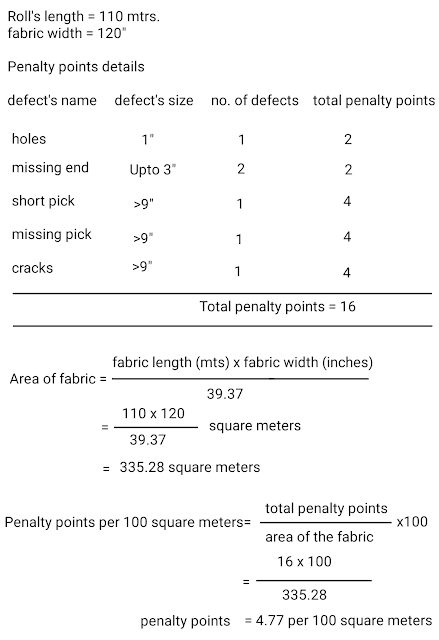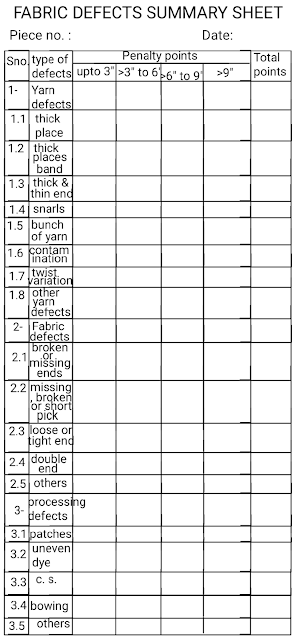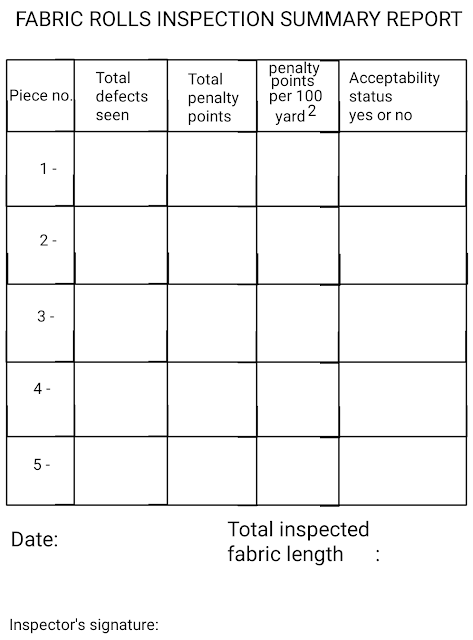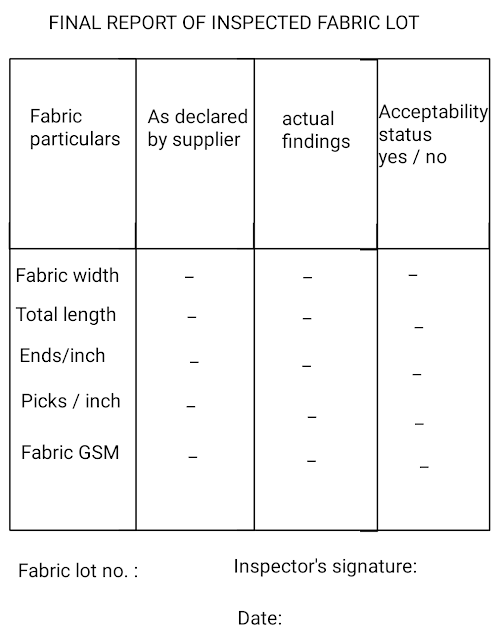25+ years experience in textile industry. The place where you can find practical solution of your problems. Consultancy service available for new and cost effective weaving and processing projects, efficiency ,product quality optimization. Fabric and yarn sourcing available. The online consultancy available.
Wednesday, December 11, 2019
4 — POINT SYSTEM, A WOVEN FABRIC GRADING SYSTEM
All the above-described reasons make clear that woven fabric has some possible defects. Some of the fabric may be much detective and some fabric may have very few defects. Both fabrics can’t be sold at an equal price.
It is also very true that the fabric having minimum defects sells at maximum price, and fabric having maximum defects sells at minimum price. All these reasons necessitate a standard fabric grading system. This grading system helps to decide the actual and correct price of any fabric lot, there are many kinds of grading systems are used in the different regions of the world.
4 — point fabric grading system has worldwide acceptability. The simplicity of this system makes it more popular among other woven fabric grading systems. This system is easily applicable in fabric manufacturing units. The important information of 4 — points system are given below:
• 10 % fabric quantity of the whole lot should be inspected.
• If the fabric lot has many colours of the same fabric quality, then the inspected quantity is decided according to the quantity of each shade.
• The fabric rolls having 40 penalty points per 100 square yards or 48 penalty points per 100 square meters are considered as first-grade quality. The fabric rolls containing more penalty points than tolerance limit are graded as second quality fabric. The penalty points per 100 square meters are calculated as below:

DEFECTS CLASSIFICATION IN 4 — POINT SYSTEM:
The defect size and penalty points to be imposed are given in below table:

INDIVIDUAL PIECE INSPECTION SHEET:

FABRIC DEFECTS SUMMARY SHEET OF A PIECE:

FABRIC ROLLS INSPECTION SUMMARY REPORT:

FINAL REPORT OF INSPECTED FABRIC LOT:

Please click on the below video link to watch the full article in Hindi:
ТКАНИ ИНСПЕКЦИЯ СТАНДАРТ ( 4-Точка системы )
ноябрь 5, 2014
Четыре-Point System, стандарт созданный в соответствии ASTM D5430 – 07(2011), стандартизированные тестовые методы для ткани визуального контроля и Аттестаций.
Система Four-Point принимается в качестве основы системы контроля DQC, поскольку он получил широкое признание в инспекции ткани из-за ее практическое, беспристрастный, и признанные во всем мире.

В системе четыре точки, максимум четыре штрафных очков может быть оценен для любого одиночного дефекта и не линейный двор не может быть оценен для любого одиночного дефекта и не линейный двор не может быть оценен более чем в четыре очка, независимо от числа дефектов в пределах этого куска.
Дефекты как основы / заполнения и направления будут назначены пункты по следующим критериям.
1 точка – Дефекты до 3″
2 точки – дефекты > 3″ ≤ 6″
3 точки – дефекты > 6″ ≤ 9″
4 точки – дефекты > 9″
Любой дефект непрерывного характера должны быть назначены четыре точки для каждого двора, в котором оно происходит.
Тяжелые дефекты назначаются максимальная четыре точки для каждого двора, в котором они происходят. пример: независимо от размера, дыра наказываться четыре очка.
Продолжающиеся условия, такие как Барра, боковые стороны центра затенение, свернуть свернуть затенение, узкая или неправильная ширина, биговки и неравномерное покрытие должны быть подсчитаны четыре очка за каждый ярд в рулоне, который находится содержит эти условия.
Четыре точки должна быть отнесена к каждому двору досматриваемого рулона, который содержит этот тип затенения дефекта.
Максимальное наказание для любого двора должно быть не более чем на четыре очка.
Отдельные валки, превышающие заданного уровень точки отсчета должны быть градуированными в качестве второго качества. Груз должен быть не прошел проверку, если количество очков отгрузки штрафа превышают установленный уровень точек отсчета.
Читайте также: Как гладить хлопчатобумажную ткань
Любой рулон, имеющий ход или повторение дефекта более чем через десять непрерывных ярдов должен быть забракован независимо от числа точек.
Нет рулон, который содержит более чем четыре полных ширины дефектов на сто ярдов линейных, должен быть принят в качестве первого качества.
Любой рулон обнаружены дефекты, в любом приращению ста ярдов, в среднем более одного крупного дефекта на десять линейных ярдов будет отвергнут.
Ни один рулон не должен быть принят, что содержит главный дефект в первых или последних трех ярдах валков. Основной дефект считаются любыми три или четыре точечными дефекты.
Ни один рулон не должен быть принят в качестве первого качества, который проявляет заметную степень потерять или герметичности вдоль одной или обеих кромок, или ряби, морщит, складки или складки в теле ткани, которая бы предотвратить ткань от лежа, когда распространяется обычным способом.
Рулеты с боку на бок, боковая сторона центр, или встык затенение, должно быть не менее 4.0 Серый рейтинг Масштаба по ААТССУ серой шкалы или удовлетворить требования клиента.
Fabric Inspection | Four Point System
Fabric Inspection | Four Point System
Denim Wet Process | Bleach Wash | Acid Wash
Garment Finishing | Pressing | Flow Chart of Garment Finishing
Quality Control | AQL (Acceptance Quality Level)
Acid Wash / Random Wash
Md. Omar Faruk
@sheemonfarooq
Md. Omar Faruk
Latest posts by Md. Omar Faruk (see all)
Fabric Inspection | Four Point System
Inspection: The essential process of maintaining the quality of raw materials used during making the finished product is called inspection. For garments, need to check the quality of fabric, sewing thread, trims etc. The process is done following a specific SOP to check the specific items.
Four-Point System: Most used method in garment industry for fabric inspection which is performed following ASTM D5430-93 ( Standard Test Methods for Visually Inspecting and Grading Fabrics ). Defects are indentified at a clearly noticable distance of 3 feet and marked with points. Every possible defects has a demerit point depending on its severity in this system.

To use this system someone have to know following things:
- Fabric inspection method or preparation
- Vast idea on nature of fabric defects (how an error looks and its appearance)
- Criteria of giving penalty points based on defects and defect length
- Calculation method of total penalty points for total defects found in a fabric roll or than
- A Check sheet or format for recording data
Fabric Inspection Method:
Fabric is inspected to determine its acceptability from a quality view point. There are various fabric inspection systems such as-
Defect Classification: The 4-Point System assigns 1, 2, 3 and 4 penalty points according to the size, quality, and significance of the defect. No more than 4 penalty points is assigned for any single flaw. A defect can be measured either length or width direction; the system remains the same. Only major errors are considered. No penalty points are assigned to minor defects. Whenever errors are recognized during fabric inspection under 4 points system and defect must be assigned a number of points depending on the severity or length.
From 0 > 3″ length/width
From 3.1″ > 6″ length/width
75mm > 150mm
From 6.1″ > 9″ length/width
150mm > 230mm
More than 9″ length/width
More than 230mm
Only major defects are taking into account. A serious defect is any defect that would cause a final garment to be considered a second.
* Upon the number and the size of the imperfections in the given yard, a maximum of 4 points can be given to one linear yard.
* Four points can be given for each linear yard when a defect is running continuously along the length of the fabric.
* Hole point may be evaluated by size.
Holes and openings (the largest dimension)
General Inspection Procedures
- Fabric inspection is done in suitable and safe environment with enough ventilation and proper lighting.
- Fabric passing through the frame must be between 45-60 degree angles to inspector and must be done on appropriate Cool White light 2 F96 fluorescent bulbs above viewing area. Back light can be used as and when needed.
- Fabric speed on inspection machine must not be more than 15 yards per minute.
- Standard approved bulk dye lot standards for all approved lots must be available prior to inspection (if possible)
- Approved standard of bulk dye lot must be available before starting inspection for assessing color, construction, finish and visual appearance.
- Shade continuity within a roll by checking shade variation between centre and selvage and the beginning, middle and end of each roll must be evaluated and documented.
- Textiles like knits must be evaluated for weight against standard approved weight.
- Fabric width must be checked from selvage to selvage against standard.
- All defects must be flagged during inspection
- The length of each roll inspected must be compared to length as mentioned on supplier ticketed tag and any deviation must be documented and reported to mill for additional replacement to avoid shortage.
- If yarn dyed or printed fabrics are being inspected the repeat measurement must be done from beginning, middle and end of selected rolls.
No penalty points are recorded or assigned for minor defects. Only major defects are considered.
Calculation of total points per yards
In 4 point system fabric quality is evaluated by unit points/100 yd 2
Acceptable Level:
Many used to say that up to 40 points per 100 square yards is acceptable. In the apparel and textile industry, textile mills, apparel brands and buyers set their own standards for acceptable points. A standards level is set by ASTM.
Many mills grade fabrics as first quality and second quality instead of just Pass/Fail the fabric roll or fabric lot. Again grading is done based number of penalty points per 100 square yards.
One more thing you should remember that acceptable points can be defined as points per 100 linear yards as well as points per 100 square yards. Secondly, acceptable points for individual roll and acceptable average points of all roll are set at different level.
An international buyer that explains something like following
any running defect more than 4 continuous yards will cause the roll to be rejected.
- Fabric width up to 64-66 inches shall be classified as first quality if number of penalty points there in does not exceed 50 points per 100 linear yards.
- For fabric width wider than 64-66 inches acceptable penalty points should be proportion of 50 points per 100 linear yards. (Use 64 inch for such calculation)
In general, acceptable level of ‘points per 100 linear yards’ or ‘points per 100 square yards’ are different for different fabric types. For example:
For Cotton Twill/Denim 28 points per 100 square yards (23 points per 100 square meters) for individual fabric roll
For All synthetic fabrics 20 point per 100 square yards (16 points per 100 square meters) for individual fabric roll
Example: A fabric roll 120 yards long and 46 inch wide contains following defects.
Defects point
4 defects up to 3 inch length
3 defects from 3 to 6 inch length
2 defects from 6 to 9 inch length
1 defect over 9 inch length
1 hole over 1 inch
Total defect points
=15.652. So, defect is acceptable.
Check sheet or Inspection Format
To record or to collects defects during inspection a simple check sheet must b used. A check sheet includes general details, details of fabric lot, fabric defects according their sizes, summary of fabric defects, quantity inspected and total penalty points and result of the fabric lot after inspection. Use tally marking for recording of number of defects. A sample 4 point system fabric inspection format has been attached at the bottom.
Types of defects found in fabric
Fabric checker should know common defects found in fabrics and he must recognize defects on the fabric at the time of fabric inspection. Some fabric defects are given below:
A major defect is any defect that, if found in a finished fabric /garment, would classify that fabric / garment as a second- rated.
slubs, hole, missing yarn, conspicuous yarn variation, end out, soiled yarn, wrong yarn.
mixed yarn, yarn variation, runner, needle line, barre, slub, hole, and press off.
The Quality Inspector may include any other defect which he feels are of a major category and may forward such defect details to the customer for feed back as and when required.
Minimum acceptable width
This width is excluding selvedge. Fabric width will be checked minimum of three times during the inspection of a piece (beginning, middle and end of a piece). Pieces having a width of measurement of less than the specified purchased width shall be graded as second quality.
Defects Rules:
- A continuous of defect shall be assigned four points for each linear meter or yard in which it occurs.
- Any piece having a running defect through more than three continuous linear meters or yards shall be rejected. Regardless in point count.
- Any piece with a full width defect over six inches in length shall be rejected.
- Any piece that contains more than three full width defects per one hundred linear meters or yards shall rejected.
- No piece shall be accepted that contains a full width defect in the first and last three meters or yards.
- A hole or torn is considered to be a major defect and shall be penalized four
- Fabric construction and weight, No tolerance will be allowed.
- The distance between major defects should be more than 20 meters.
- All major and full width defects should be seemed a polyester thread at the selvedge.
- Waviness, tightness, ripples, puckering in body of fabric which would prevent the fabric from lying flat when spread in a conventional manner is not acceptable.
Following defects will be penalized penalty points as per rules:
Kinks, Knots, slub, contamination, spot, and half/double pick, cockled yarn, coarse pick. Heavy weft bar below 6” in length, set mark, rapping, broken pick, out mark, holes & float up to ¼ “
Following defects are cut table and will be rejected:
- Frequent kinks, knots, slub, contamination, spots etc
- Any continuous defect
- More than one meters broken end, double end, wrong draw reed mark
- Holes torn and float above ¼ “
- Irregular selvedge, light weft bar, count variation, Lecco, shade variation
- Heavy weft bar above 6: in length
- The most commonly used system is the American 4 point system.
- The ASTM D5430 standard explains how to assign points to each defect–mostly based on its size.
- The overall result consists of two numbers (and they are all most buyers want to know regarding defects):
- The average number of points (on a 100 meters basis) of all inspected rolls,
- The proportion of rolls above acceptance limit.
Maximum Acceptable Points = 20 points per 100 sq. yards or 22 points per 100 sq. meters.
- Свежие записи
- Балкон в многоквартирном доме: является ли он общедомовым имуществом?
- Штраф за остекление балкона в 2022: что это и как избежать наказания
- Штраф за мусор с балкона: сколько заплатить за выбрасывание окурков
- Оформление балконного окна: выбираем шторы из органзы
- Как выбрать идеальные шторы для маленькой кухни с балконом
